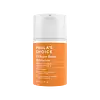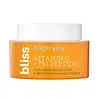Paula's Choice C5 Super Boost Moisturizer Versus Bliss Bright Idea Vitamin C + Tri-Peptide Collagen Protecting & Brightening Moisturizer
What's inside
What's inside
 Key Ingredients
Key Ingredients

 Benefits
Benefits

 Concerns
Concerns

 Ingredients Side-by-side
Ingredients Side-by-side

Water
Skin ConditioningDicaprylyl Carbonate
Emollient3-O-Ethyl Ascorbic Acid
Skin ConditioningDimethicone
EmollientButylene Glycol
HumectantPolyglyceryl-6 Distearate
EmulsifyingAscorbyl Glucoside
AntioxidantSqualane
EmollientHydroxyethyl Acrylate/Sodium Acryloyldimethyl Taurate Copolymer
Emulsion StabilisingAcetyl Sh-Hexapeptide-5 Amide Acetate
Skin ConditioningCitrullus Lanatus Seed Oil
EmollientHydrogenated Lecithin
EmulsifyingTheobroma Cacao Seed Butter
EmollientHydrogenated Phosphatidylcholine
EmulsifyingPentaerythrityl Tetra-Di-T-Butyl Hydroxyhydrocinnamate
AntioxidantSodium Hyaluronate
HumectantOryza Sativa Bran Extract
Skin ConditioningPropanediol
SolventJojoba Esters
EmollientTocopherol
AntioxidantAcetyl Zingerone
AntioxidantCetyl Palmitate
EmollientCaprylyl Glycol
EmollientCetyl Alcohol
EmollientPolyglyceryl-3 Beeswax
EmulsifyingSodium Hydroxide
BufferingSorbitan Olivate
EmulsifyingSorbitan Palmitate
EmulsifyingHelianthus Annuus Extract
EmollientEthylhexylglycerin
Skin ConditioningHexylene Glycol
EmulsifyingSodium Phytate
Polysorbate 60
EmulsifyingSorbitan Isostearate
EmulsifyingLecithin
EmollientRosmarinus Officinalis Leaf Extract
AntimicrobialGlycine Soja Oil
EmollientLysolecithin
EmulsifyingBacillus Ferment
Skin ConditioningCitric Acid
BufferingPolyglutamic Acid
Skin ConditioningBeta-Sitosterol
Emulsion StabilisingPhytic Acid
Squalene
EmollientPhenoxyethanol
PreservativeSodium Benzoate
MaskingPotassium Sorbate
PreservativeWater, Dicaprylyl Carbonate, 3-O-Ethyl Ascorbic Acid, Dimethicone, Butylene Glycol, Polyglyceryl-6 Distearate, Ascorbyl Glucoside, Squalane, Hydroxyethyl Acrylate/Sodium Acryloyldimethyl Taurate Copolymer, Acetyl Sh-Hexapeptide-5 Amide Acetate, Citrullus Lanatus Seed Oil, Hydrogenated Lecithin, Theobroma Cacao Seed Butter, Hydrogenated Phosphatidylcholine, Pentaerythrityl Tetra-Di-T-Butyl Hydroxyhydrocinnamate, Sodium Hyaluronate, Oryza Sativa Bran Extract, Propanediol, Jojoba Esters, Tocopherol, Acetyl Zingerone, Cetyl Palmitate, Caprylyl Glycol, Cetyl Alcohol, Polyglyceryl-3 Beeswax, Sodium Hydroxide, Sorbitan Olivate, Sorbitan Palmitate, Helianthus Annuus Extract, Ethylhexylglycerin, Hexylene Glycol, Sodium Phytate, Polysorbate 60, Sorbitan Isostearate, Lecithin, Rosmarinus Officinalis Leaf Extract, Glycine Soja Oil, Lysolecithin, Bacillus Ferment, Citric Acid, Polyglutamic Acid, Beta-Sitosterol, Phytic Acid, Squalene, Phenoxyethanol, Sodium Benzoate, Potassium Sorbate
Water
Skin ConditioningGlycerin
HumectantCaprylic/Capric Triglyceride
MaskingPropanediol
SolventCetearyl Alcohol
Emollient3-O-Ethyl Ascorbic Acid
Skin ConditioningCoco-Caprylate/Caprate
EmollientHydrogenated Farnesene
EmollientGlyceryl Stearate
EmollientButyrospermum Parkii Butter
Skin ConditioningLimnanthes Alba Seed Oil
Skin ConditioningPalmitoyl Tripeptide-5
Skin ConditioningGlycyrrhiza Glabra Root Extract
BleachingSaccharide Isomerate
HumectantCeramide Ng
Skin ConditioningTocopherol
AntioxidantNiacinamide
SmoothingMangifera Indica Fruit Extract
Skin ConditioningEuterpe Oleracea Fruit Extract
Camellia Sinensis Leaf Extract
AntimicrobialPseudozyma Epicola/Camellia Japonica Seed Oil Ferment Extract Filtrate
Emulsion StabilisingAloe Barbadensis Leaf Juice
Skin ConditioningPersea Gratissima Oil
Skin ConditioningGlycine Soja Oil
EmollientSimmondsia Chinensis Seed Oil
EmollientArgania Spinosa Kernel Oil
EmollientXanthan Gum
EmulsifyingAcacia Senegal Gum
MaskingHydroxyacetophenone
AntioxidantCetearyl Olivate
Caprylyl Glycol
EmollientPolyacrylate Crosspolymer-6
Emulsion StabilisingHydroxyethyl Acrylate/Sodium Acryloyldimethyl Taurate Copolymer
Emulsion StabilisingPolyglyceryl-4 Laurate/Succinate
PEG-100 Stearate
Sorbitan Olivate
EmulsifyingCetearyl Glucoside
EmulsifyingHexylene Glycol
EmulsifyingEthoxydiglycol
HumectantSodium Citrate
BufferingTetrasodium Glutamate Diacetate
Sodium Metabisulfite
AntioxidantPhenoxyethanol
PreservativeEthylhexylglycerin
Skin ConditioningPotassium Sorbate
PreservativeSodium Benzoate
MaskingCitric Acid
BufferingParfum
MaskingLimonene
PerfumingWater, Glycerin, Caprylic/Capric Triglyceride, Propanediol, Cetearyl Alcohol, 3-O-Ethyl Ascorbic Acid, Coco-Caprylate/Caprate, Hydrogenated Farnesene, Glyceryl Stearate, Butyrospermum Parkii Butter, Limnanthes Alba Seed Oil, Palmitoyl Tripeptide-5, Glycyrrhiza Glabra Root Extract, Saccharide Isomerate, Ceramide Ng, Tocopherol, Niacinamide, Mangifera Indica Fruit Extract, Euterpe Oleracea Fruit Extract, Camellia Sinensis Leaf Extract, Pseudozyma Epicola/Camellia Japonica Seed Oil Ferment Extract Filtrate, Aloe Barbadensis Leaf Juice, Persea Gratissima Oil, Glycine Soja Oil, Simmondsia Chinensis Seed Oil, Argania Spinosa Kernel Oil, Xanthan Gum, Acacia Senegal Gum, Hydroxyacetophenone, Cetearyl Olivate, Caprylyl Glycol, Polyacrylate Crosspolymer-6, Hydroxyethyl Acrylate/Sodium Acryloyldimethyl Taurate Copolymer, Polyglyceryl-4 Laurate/Succinate, PEG-100 Stearate, Sorbitan Olivate, Cetearyl Glucoside, Hexylene Glycol, Ethoxydiglycol, Sodium Citrate, Tetrasodium Glutamate Diacetate, Sodium Metabisulfite, Phenoxyethanol, Ethylhexylglycerin, Potassium Sorbate, Sodium Benzoate, Citric Acid, Parfum, Limonene
 Reviews
Reviews

Ingredients Explained
These ingredients are found in both products.
Ingredients higher up in an ingredient list are typically present in a larger amount.
You might know this ingredient as Ethyl Ascorbic Acid, a more stable version of ascorbic acid.
Like other types of vitamin C, this ingredient has many benefits including reducing wrinkles, skin soothing, dark spot fading, and fighting against free radicals.
3-O-Ethyl Ascorbic Acid interferes with the process of skin darkening, helping to reduce hyperpigmentation. It also encourages the skin to produce more collagen.
Once applied, 3-O-Ethyl Ascorbic Acid is converted to Vitamin C deeper in the skin's layers. This process is slow but makes this ingredient more tolerable for skin.
The optimum pH range for this ingredient is 4 - 5.5
Learn more about 3-O-Ethyl Ascorbic AcidCaprylyl Glycol is a humectant and emollient, meaning it attracts and preserves moisture.
It is a common ingredient in many products, especially those designed to hydrate skin. The primary benefits are retaining moisture, skin softening, and promoting a healthy skin barrier.
Though Caprylyl Glycol is an alcohol derived from fatty acids, it is not the kind that can dry out skin.
This ingredient is also used as a preservative to extend the life of products. It has slight antimicrobial properties.
Learn more about Caprylyl GlycolCitric Acid is an alpha hydroxy acid (AHA) naturally found in citrus fruits like oranges, lemons, and limes.
Like other AHAs, citric acid can exfoliate skin by breaking down the bonds that hold dead skin cells together. This helps reveal smoother and brighter skin underneath.
However, this exfoliating effect only happens at high concentrations (20%) which can be hard to find in cosmetic products.
Due to this, citric acid is usually included in small amounts as a pH adjuster. This helps keep products slightly more acidic and compatible with skin's natural pH.
In skincare formulas, citric acid can:
While it can provide some skin benefits, research shows lactic acid and glycolic acid are generally more effective and less irritating exfoliants.
Most citric acid used in skincare today is made by fermenting sugars (usually from molasses). This synthetic version is identical to the natural citrus form but easier to stabilize and use in formulations.
Read more about some other popular AHA's here:
Learn more about Citric AcidEthylhexylglycerin (we can't pronounce this either) is commonly used as a preservative and skin softener. It is derived from glyceryl.
You might see Ethylhexylglycerin often paired with other preservatives such as phenoxyethanol. Ethylhexylglycerin has been found to increase the effectiveness of these other preservatives.
Glycine Soja Oil comes from the soybean. Glycine Soja is native to eastern Asia.
Soybean oil is an emollient. It is rich in antioxidants and fatty acids including palmitic, stearic, oleic, and linoleic acids.
As an emollient, the fatty acids in soybean oil helps keep your skin soft and hydrated. It does so by creating a film on top that traps moisture in.
Soybean oil is also rich in vitamin E, a potent antioxidant. Vitamin E is also anti-inflammatory and provides a soothing effect.
Studies show soy may help fade hyperpigmentation from UVB. It does so by disrupting the melanin process from UVB induced skin inflammation.
This ingredient may not be malassezia folliculitis, or fungal-acne, safe.
Soybeans are rich in proteins and are part of the legume family. Foods made with soybeans include tofu, soymilk, edamame, miso, and soy sauce.
Learn more about Glycine Soja OilHexylene Glycol is a surfactant. Glycols are a class of alcohols. Hexylene Glycol is a surfactant and emulsifier.
As a surfactant, Hexylene Glycol helps gather dirt and oil on your skin to be washed away.
As an emulsifier, Hexylene Glycol helps keep water and oil together. This prevents them from separating in a product. Hexylene Glycol also thins out the texture of a product by lessening viscosity.
Hexylene Glycol has a small molecular weight.
Learn more about Hexylene GlycolThis is a synthetic polymer. It helps improve the texture of products by adding thickness and gel-like feel.
It is also an emulsifer, meaning it prevents ingredients such as oil and water from separating. It also helps evenly disperse other ingredients.
Phenoxyethanol is a preservative that has germicide, antimicrobial, and aromatic properties. Studies show that phenoxyethanol can prevent microbial growth. By itself, it has a scent that is similar to that of a rose.
It's often used in formulations along with Caprylyl Glycol to preserve the shelf life of products.
Potassium Sorbate is a preservative used to prevent yeast and mold in products. It is commonly found in both cosmetic and food products.
This ingredient comes from potassium salt derived from sorbic acid. Sorbic acid is a natural antibiotic and effective against fungus.
Both potassium sorbate and sorbic acid can be found in baked goods, cheeses, dried meats, dried fruit, ice cream, pickles, wine, yogurt, and more.
You'll often find this ingredient used with other preservatives.
Learn more about Potassium SorbatePropanediol is an all-star ingredient. It softens, hydrates, and smooths the skin.
It’s often used to:
Propanediol is not likely to cause sensitivity and considered safe to use. It is derived from corn or petroleum with a clear color and no scent.
Learn more about PropanediolSodium Benzoate is a preservative. It's used in both cosmetic and food products to inhibit the growth of mold and bacteria. It is typically produced synthetically.
Both the US FDA and EU Health Committee have approved the use of sodium benzoate. In the US, levels of 0.1% (of the total product) are allowed.
Sodium benzoate works as a preservative by inhibiting the growth of bacteria inside of cells. It prevents the cell from fermenting a type of sugar using an enzyme called phosphofructokinase.
It is the salt of benzoic acid. Foods containing sodium benzoate include soda, salad dressings, condiments, fruit juices, wines, and snack foods.
Studies for using ascorbic acid and sodium benzoate in cosmetics are lacking, especially in skincare routines with multiple steps.
We always recommend speaking with a professional, such as a dermatologist, if you have any concerns.
Learn more about Sodium BenzoateSorbitan Olivate is created from the fatty acids in olive oil and sorbitol.
This ingredient is an oil in water emulsifier. It helps stabilize a product by preventing oils and waters from separating. Sorbitan Olivate also helps hydrate the skin.
Manufacturers sell sorbitan olivate under the name OliveM 1000. OliveM 1000 a multifunctional ingredient. It is self-emulsifying. According to a manufacturer, OliveM 1000 does not disrupt natural skin biome.
Due to its olive oil base, this ingredient may not be fungal-acne safe.
Learn more about Sorbitan OlivateTocopherol (also known as Vitamin E) is a common antioxidant used to help protect the skin from free-radicals and strengthen the skin barrier. It's also fat soluble - this means our skin is great at absorbing it.
Vitamin E also helps keep your natural skin lipids healthy. Your lipid skin barrier naturally consists of lipids, ceramides, and fatty acids. Vitamin E offers extra protection for your skin’s lipid barrier, keeping your skin healthy and nourished.
Another benefit is a bit of UV protection. Vitamin E helps reduce the damage caused by UVB rays. (It should not replace your sunscreen). Combining it with Vitamin C can decrease sunburned cells and hyperpigmentation after UV exposure.
You might have noticed Vitamin E + C often paired together. This is because it is great at stabilizing Vitamin C. Using the two together helps increase the effectiveness of both ingredients.
There are often claims that Vitamin E can reduce/prevent scarring, but these claims haven't been confirmed by scientific research.
Learn more about TocopherolWater. It's the most common cosmetic ingredient of all. You'll usually see it at the top of ingredient lists, meaning that it makes up the largest part of the product.
So why is it so popular? Water most often acts as a solvent - this means that it helps dissolve other ingredients into the formulation.
You'll also recognize water as that liquid we all need to stay alive. If you see this, drink a glass of water. Stay hydrated!
Learn more about Water